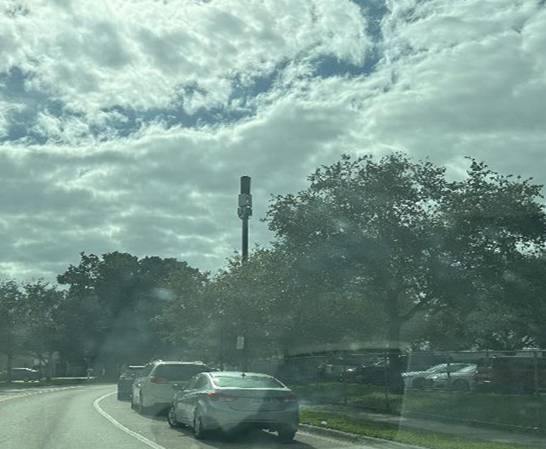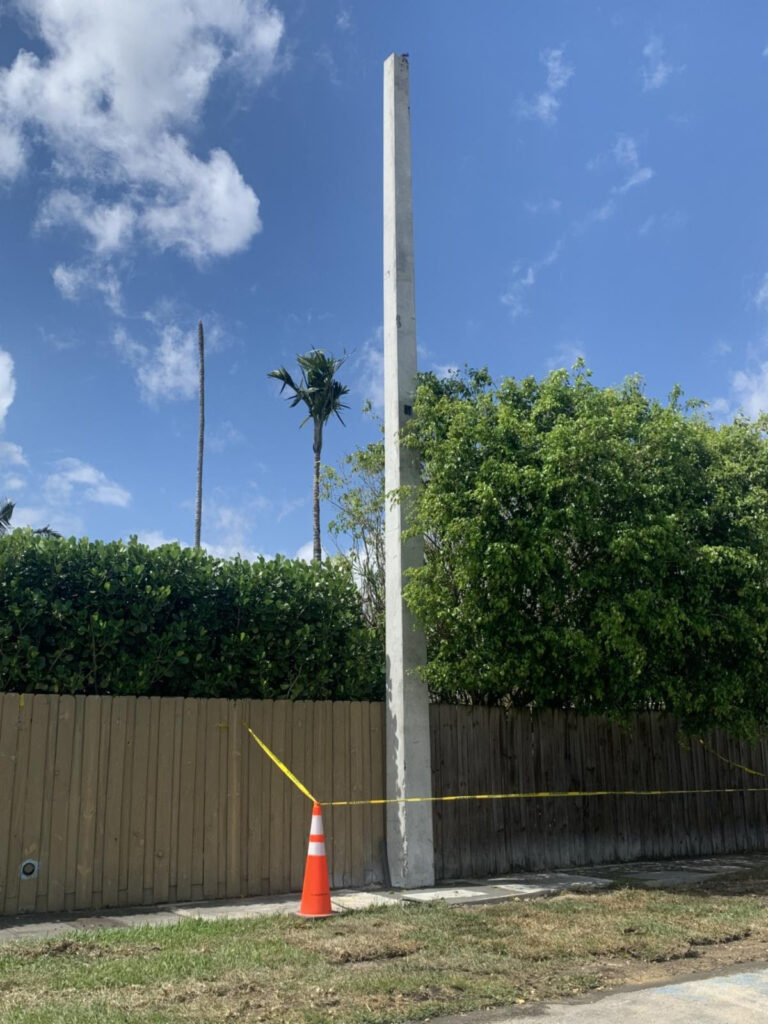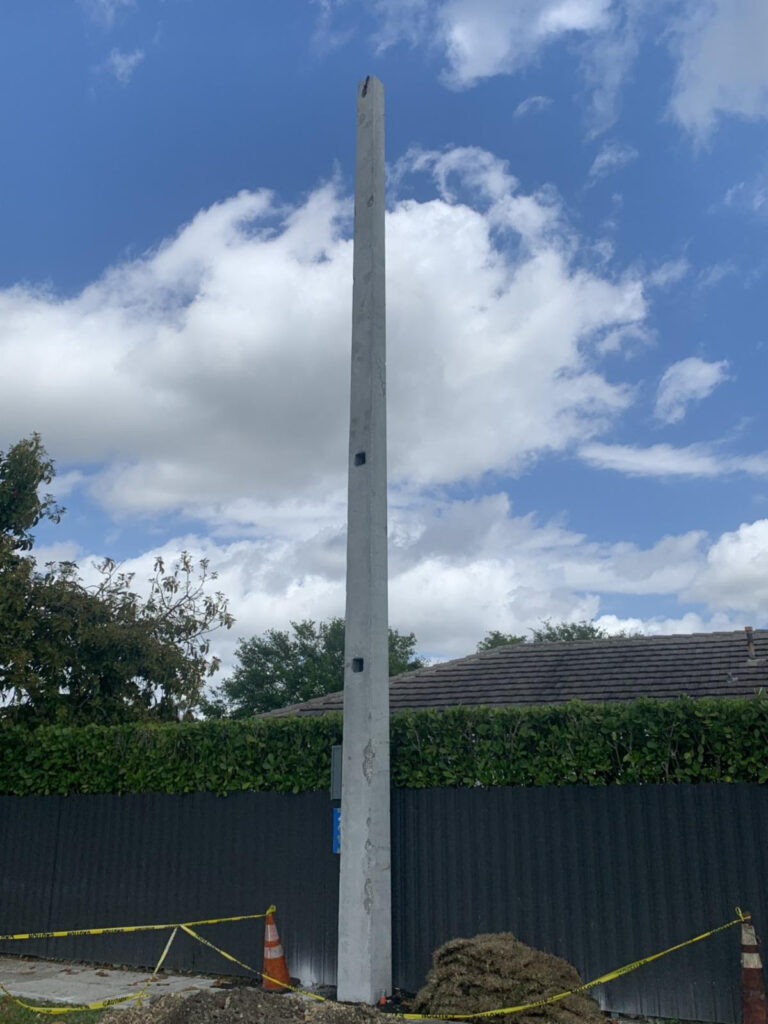The KFHA will host a community meeting Tuesday
Imagine leaving for work one Wednesday morning and coming home in the afternoon to find a 32-foot, cement pole in your front yard and a box next to it with a sticker that warns about chemicals that have caused Cancer in California. This is happening to a bunch of Kendall residents.
Homeowners from communities like Glen Cove, the Crossings and Winston Park have been watching these giant obelisks pop up on their public sidewalks for months. And they’re coming at a fast clip because there are dedicated employees in permitting working just for the telecommunications companies. Sabal Chase and Calusa could be next.
“It’s a surprise and a slap in the face,” said Jen Zambolla, who sits on the board of the Winston Park Homeowner’s Association.
“It’s dramatic,” said Sylvia Gutierrez, who chairs the Crime Watch committee in Glen Cove. “Our area has underground utilities. There are no poles. And these look like Washington Monuments.”
Gutierrez counted four towers go up in one month in the area around Killian and 117th.
“This has been done in a very stealth manner by a county mayor that claims to be transparent,” said Gus Robayna, who also lives in Glen Cove. “You leave at 8 in the morning and at 5 p.m., there’s a pole.
“We don’t even have street lights. And they’re just popping right up in the middle of the street,” he said.
The Kendall Federation of Homeowners Association will have a community meeting on Tuesday to discuss what they call the “invasion of the towers” and try to find ways to stop it.
“While we are not certain what can be done, we do need to stand strong and get answers,” reads an email blast that was sent out last week.
“How is it that there is no public input for where these towers are going? Do we just keep our fingers crossed and hope that we are not one of the unfortunate homeowners that gets one of these towers next to their home?”
KFHA President Michael Rosenberg, who sent Political Cortadito these photos, has asked a bunch of times and gotten several email responses from county officials who say that there is nothing that they can do and that thousands of 5G micro-facilities” will be installed by multiple different companies.
In other words: Too bad, not so sad.
He’s also communicated directly with Crown Castle, one of the communications companies, which states on their website that they “involve your local community and government leaders in every step of the process—ensuring that your unique needs are met, and that you can continue to live life the way you’ve come to expect for many years to come.” No local community has been involved.
“Not a single one,” Rosenberg said.
“This is a state mandate,” Nestor Melian, chief of Permits and Inspection in the Transit Project Management and Support Division of the Miami-Dade Department of Transportation and Public Works — how does that fit on a business card? — wrote in January.
“These are not County projects and as per the Statute we do not have the ability to limit or reject these micro-facilities. If you have any question about a specific antenna and location, we are able to get you in contact with a field specialist from the provider,” Melian wrote.
How is that going to help? The providers are not our elected leaders and representatives.
Read related: Kendall teacher challenges Miami-Dade D11 Commissioner Roberto Gonzalez
In February, Melian told Department of Regulatory & Economic Resources Director Lourdes Gomez, who had inquired about the resident questions, the same thing. “This inquiry has been addressed in several instances to the constituents, and it has been explained that as per Section 337.401(7) of the Florida Statutes requires the County to permit these types of micro-wireless facilities in the public rights-of-way and limits the County’s ability to regulate them,” he wrote to Gomez.
“The statute does not allow the County either to deny an installation based on its proximity to a home or to enforce FCC requirements. The state law that governs County approvals does not give the County the authority to enforce federal law. Complaints regarding violations of federal regulations may be referred to the FCC. We only review the permits that are received, and as per the statutes, we are required to permit these types of micro-wireless facilities,” Melian continued.
He said the county’s review is limited to safety issues like “sight distance triangle” and American with Disabilities Act compliance, which Ladra cannot imagine these towers comply with since they often leave a much narrower space on the sidewalk.
And he seems to be at least partially right. The 2019 “contracting, acquisition, disposal and use of property” law grants very broad powers to telecommunications companies when it comes to where and when they place their possibly cancerous 5G antenna towers, which are designed to bring high-speed internet to every corner of the state. Because the new fifth generation (5G) technology uses a much higher radio frequency, signals travel shorter distances than regular cellphone technology and are easily blocked by trees or buildings. Which is why they are popping up everywhere.
They’ve also been unwelcome in many places, because of fears that they cause cancer. The American Cancer Society is noncommittal. “There’s no strong evidence that exposure to [radio frequency] waves from cell phone towers causes any noticeable health effects,” the organization says on its website. “However, this does not mean that the RF waves from cell phone towers have been proven to be absolutely safe. Most expert organizations agree that more research is needed to help clarify this, especially for any possible long-term effects.”
Gutierrez says it’s not just about the health effects of the 5G towers. It’s also about the neighborhood aesthetics and possible hit to property values. “They totally change the curb appeal.”
The 2019 legislature apparently anticipated some resistance. Or, rather, the telecommunications companies who then hired lobbyists to get this done anticipated some challenges.
According to Florida Statute 337, the county “may not prohibit, regulate, or charge for the collocation of small wireless facilities in the public rights-of-way or for the installation, maintenance, modification, operation, or replacement of utility poles used for the collocation of small wireless facilities in the public rights-of-way.”
These things definitely do not look “small.”
The companies installing the poles are not required to tell the county how many they plan to install in the public right-of-way or where they plan to install them before they request a permit, for which they don’t have to provide any information other than what is “necessary to demonstrate the applicant’s compliance with applicable codes for the placement of small wireless facilities.” Whatever those are.
Key words: Public right-of-way. Key word: Public.
Yet, according to the statute, the county, which represents the public, is not allowed to:
- Require the placement of small wireless facilities on any specific utility pole or category of poles (there’s that word “small” again).
- Require the placement of multiple antenna systems on a single utility pole.
- Require compliance with an county’s provisions regarding placement of small wireless facilities or a new utility pole support a small wireless facilities.
- Require an electrical permit be issued before issuing the permit to construct the pole.
- Require a meeting before filing an application.
- Require direct or indirect public notification or a public meeting for the placement of communication facilities in the right-of-way.
- Limit the size or configuration of a small wireless facility or any of its components, if the small wireless facility complies with the size limits in this subsection.
- Prohibit the installation of a new utility pole used to support the collocation of a small wireless facility.
- Require that any component of a small wireless facility be placed underground.
- Limit the placement, by minimum separation distances, of small wireless facilities, utility poles on which small wireless facilities are or will be collocated, or other at-grade communications facilities.
In other words, the county can’t do squat.
But — and there’s always a but, isn’t there? — a section of the law says that the county may request, within 14 days of the filing of an application for a permit, that the small wireless facility be “moved to another location in the right-of-way.” The county and the communications companies can “negotiate the alternative location, including any objective design standard and reasonable spacing requirements for ground-based equipment for 30 days after the date of the request.”
Read related: Construction disruption starts at Calusa after court invalidates zoning change
How come nobody is doing that? It seems that nobody at the county — or the state, for that matter — is looking out for the residents who don’t know what’s happening until it’s too late.
Zambolla, vice president of communications for the Winston Park HOA, came home from work one day to find a tower on the sidewalk next door to the house. They’ve contacted Miami-Dade Mayor Daniella Levine Cava, Commissioner Anthony Rodriguez, State Sen. Ana Maria Rodriguez and State Rep. Mike Redondo — and nobody has responded, Zambolla said.
Rebecca Wakefield, the chief of staff to Commissioner Raquel Regalado, said the District 7 office has also received calls from concerned residents.
“No one likes 5G towers,” Wakefield told Political Cortadito. “We’ve reached out to the county attorney. We’re still looking around to see if there’s anything we can do. This is a problem everywhere. There’s a reason the state pre-empts us. Because nobody wants this in our neighborhoods.”
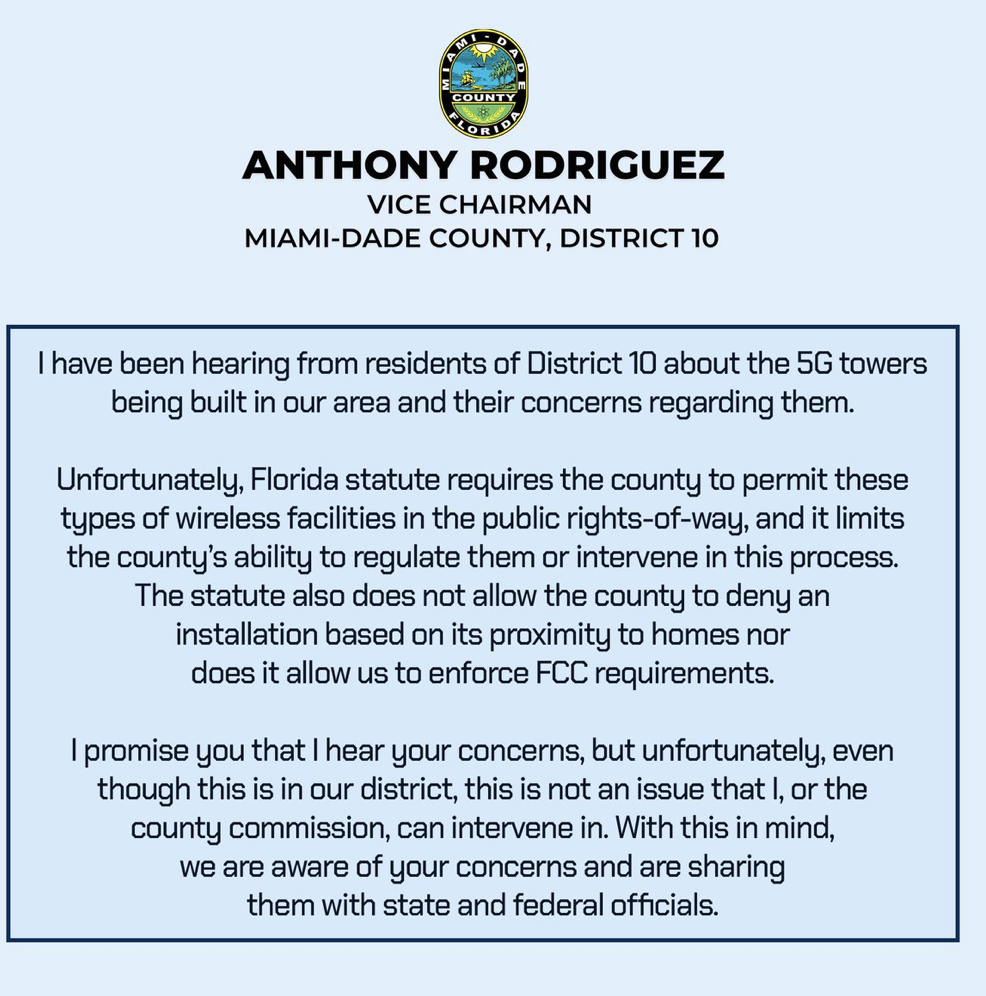
Rodriguez, the commission vice chair, posted a poor excuse on social media that acknowledged he had been hearing from residents of District 10 but passed the buck anyway. “I hear your concerns, but unfortunately, even though this is in our district, this is not an issue that I, or the county commission can intervene in,” he said.
Yeah, no, maybe. Because the truth is that the county has only made it easier for these telecommunications companies to erect these poles by assigning specific employees in the permitting department that work just to expedite these permits.
In June of last year, the county commission passed a resolution approving a “utility structure permitting agreement” with Crown Castle Fiber LLC that provided for the company to pay $170,000 “to support employing one individual with for the exclusive purpose of processing applications for permits on a priority basis for communications infrastructure facilities located within the unincorporated areas of the county.” It was modeled after an agreement three months earlier with AT&T for another employee.
It doesn’t matter that these companies pay the salaries and expenses. That makes these Miami-Dade permits processors really AT&T and Crown Castle employees, doesn’t it?
Sounds like a sneaky way to get around the 14-day appeal window. And how would anybody know to appeal anyway if there is no requirement to notice the neighborhood?
It also seems that this is a problem that is burdening the residents of the unincorporated Miami-Dade services area more than those who live in municipalities. Because the 5G tower installed in Coral Gables in 2021 is camouflaged and looks very different from the ones that are going up in Kendall. There are tech companies that are making them much less ugly and obtrusive. And yet the state law reportedly applies to any authority, not just the county.
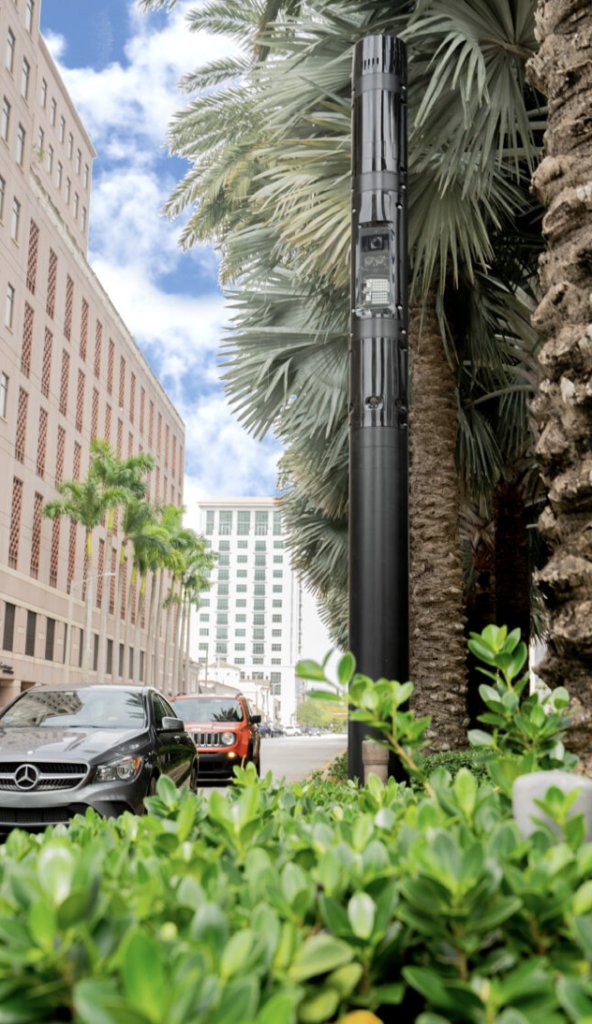
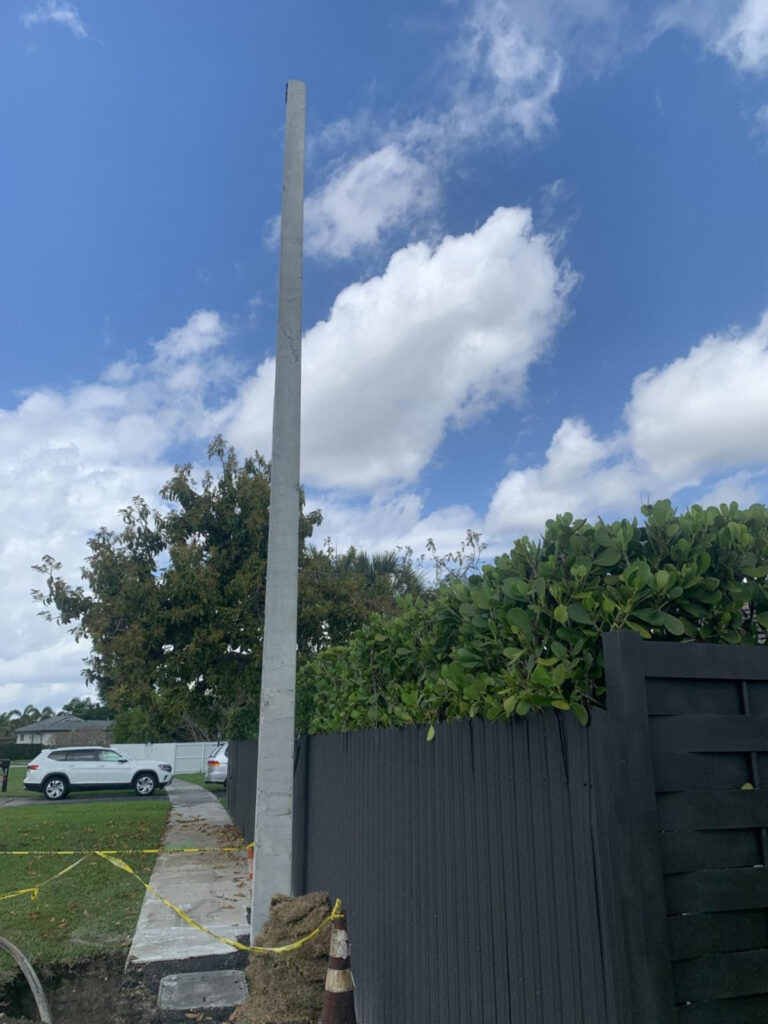
The KFHA community meeting Tuesday begins at 7 p.m. at the Kendall Village Center “Village Pavilion,” at 8625 SW 124th Avenue, in front of Regal Cinema.
Said Rosenberg: “Regardless of what seems like an overwhelming task to fight the invasion of these towers, our elected officials should be with the citizens leading the fight, not dismissing the community with a ‘there is a nothing we can do’ response.”
You know who should be there? Sen. Rodriguez and State Rep. Redondo and Speaker Danny Perez, too. If this is a state mandate, we should hold them accountable.

